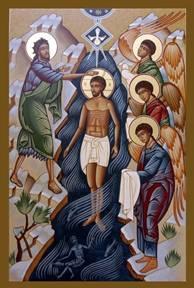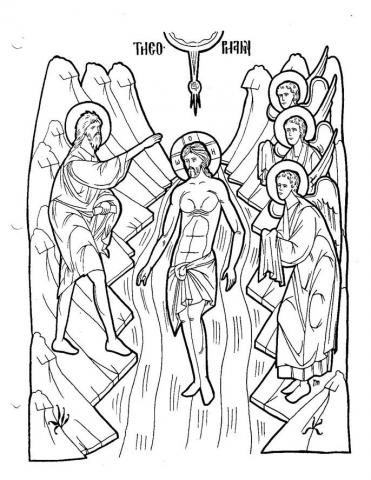Theophany
THEOPHANY
 Objectives:
Objectives:
- Students should be able to discuss the icon, knowing each character and its role.
- Students should know that Jesus was baptized in the Jordan River and be able to locate it on a map.
- Students should know the date of the feast, January 6.
- Students should be able to sing the Troparion, since they will need that for their house blessing.
Possible Lesson Plan:
- Open with prayer.
- The icon (Use this to see how much the class already knows and to retell the story.): Christ, the central figure, St. John the Baptist (why is he dressed in brown animal skin?), the angels, the Holy Spirit in the form of a dove, the river Jordan
- Scripture readings:
Gospel: Matthew 3:13-end of chapter, Luke 3:1-18, John 1:19-37
Old Testament prefigurings: Genesis 6:5-8:22 (the Flood (water) and the olive branch (oil)), Isaiah 1:16-18, Exodus 14:21-29 (Moses crossing the Red Sea), I Kings 18:30-39, II Kings 2:11-13
- Songs of the Feast:
Troparion: When thou, O Lord, wast baptized in the Jordan, the worship of the Trinity was made manifest. For the voice of the Father bore witness to Thee, and called Thee His beloved Son, and the Spirit in the form of a dove confirmed the truthfulness of His words; O Christ Our God who hast revealed Thyself and hast enlightened the world, Glory to Thee!
Practice singing the Troparion; this is the week’s memory work.
- Discussion questions:
Who was the last and greatest prophet of Israel? (John) How were the Jewish people prepared to be “shown” the Messiah? Did John recognize Jesus when He arrived? In what ways is John the new Elijah? (Elijah’s mantle of prophecy was passed on to Elisha and from him in an uninterrupted chain of prophets, of whom John is the last)
How old was Jesus when He was baptized? How had He lived up until this time? (as an ordinary working man, a carpenter, in Nazareth) Did Jesus need to be baptized because He was a sinner? Then why was He baptized? (He was fulfilling His responsibility to represent all of creation in being cleansed.)
What does Theophany mean? (Theos meaning “God” and Phanos meaning “to show”) We meet here the Trinity for the first time in the New Testament. How was the Trinity present at Theophany? We reaffirm the 3 natures of the one God every time we make the sign of the cross. How? Why do we bless the water at Theophany? What do we use it for through the year? (house blessing, illness, etc.) The feast is sometimes called “Epiphany”; what does that mean? (“Manifestation”) Why was January 6 chosen for the feast? (to replace the pagan feast of the winter solstice) The Roman Church celebrates the Magi on this date; when do we honor the Magi? (December 25)
In what ways is baptism like the crossing of the Red Sea? (Pharoah, representing Satan, was wiped out just as evil is drowned forever in the waters of baptism; the column of fire protecting the people as the Holy Spirit sanctifies the waters of baptism), John baptized with what? Jesus baptized with what?
- Review the custom of House Blessing. When do we bless houses? Who blesses them? What do we use? Where do we get the Holy Water? What do we sing?
- Ask the students if they have ever seen a baptism? What’s it like? Why are we baptized? (to become part of God’s family, the Church) Sing together “As many as have been baptized…” How was Jesus’s baptism like our baptisms? Different?
- Play a learning game: Play “Final Jeopardy”. Write each important word from today’s lesson (e.g. Theophany, John the Baptist, dove, January 6, Jesus, Noah, Elijah) on a card. Each student should have 7 cards. When the teacher shows the answer card, each student should write a question for which that would be the answer. The students turn their question cards over until all are ready. Show the questions and each correct answer gets 10 points; wrong answer loses 5. Continue through all 7 answers and questions.
- Add to your time line as before.

- Close with the Troparion and prayer.